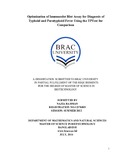| dc.contributor.advisor | Qadri, Dr. Firdausi | |
| dc.contributor.advisor | Choudhury, Prof. Dr. Naiyyum | |
| dc.contributor.author | Rahman, Nazia | |
| dc.date.accessioned | 2014-09-16T08:15:08Z | |
| dc.date.available | 2014-09-16T08:15:08Z | |
| dc.date.copyright | 2014 | |
| dc.date.issued | 2014-07 | |
| dc.identifier.other | ID 12376003 | |
| dc.identifier.uri | http://hdl.handle.net/10361/3646 | |
| dc.description | This thesis report is submitted in partial fulfillment of the requirement for the degree of Masters of Science in Biotechnology, 2014. | en_US |
| dc.description | Cataloged from PDF version of thesis report. | |
| dc.description | Includes bibliographical references (page 90-100). | |
| dc.description.abstract | Typhoid and paratyphoid (enteric) fever are responsible for morbidity and mortality
worldwide. Bangladesh is an endemic zone of enteric fever where sanitation and hygienic
conditions are poor. Rapid, accurate diagnosis of enteric fever and early treatment of the
patients with appropriate antimicrobials are essential for recovery and for prevention of
complications and death. Bone marrow culture is the gold standard for diagnosis of
enteric fever but it is an invasive procedure and blood culture method and widal test have
low sensitivity and specificity respectively. Thus development of an early and reliable
diagnostic method is necessary. Previous studies reported that a novel diagnostic method,
TPTest is very useful for diagnosis of typhoid and paratyphoid fever and it gives a
preliminary result within 24 hours and a confirmatory result after 48 hours. The
sensitivity and specificity of the TPTest are 100% and 78-97% respectively. The TPTest
detects Salmonella enterica serotype Typhi specific antibodies in peripheral blood
antibodies (PBA) specimen by ELISA. The PBA specimen is prepared by isolating the
lymphocytes form whole blood using ficoll density gradient centrifugation method and
culturing the cells at 37oC with 5% CO2 supplementation. For implication of the TPTest
in laboratories with less facilities and expertise immunodot blot assay was used to detect
the response in PBA specimen. The specimen was prepared by isolating the blood cells
using RBC lysis and culturing the cells at 37oC with no 5% CO2 supply. In this study,
optimization of the simplified methods of the TPTest was done at different stages and the
results were evaluated with the results of blood culture and with the standard TPTest
method. The findings of this study suggest that the optimized immunodot blot assay and
the simplified cell separation methods will be helpful for diagnosis of typhoid and
paratyphoid fever. | en_US |
| dc.description.statementofresponsibility | Nazia Rahman | |
| dc.format.extent | 109 pages | |
| dc.language.iso | en | en_US |
| dc.publisher | BRAC University | en_US |
| dc.rights | BRAC University thesis are protected by copyright.
They may be viewed from this source for any purpose,
but reproduction or distribution in any format is prohibited
without written permission. | |
| dc.subject | Biotechnology | en_US |
| dc.subject | Typhod | en_US |
| dc.subject | Paratyphoid | en_US |
| dc.title | Optimization of immunodot blot assay for diagnosis of Typhoid and Paratyphoid fever using the TPTest for comparison | en_US |
| dc.type | Thesis | en_US |
| dc.contributor.department | Department of Mathematical and Natural Science, BRAC University | |
| dc.description.degree | M. Biotechnology | |

